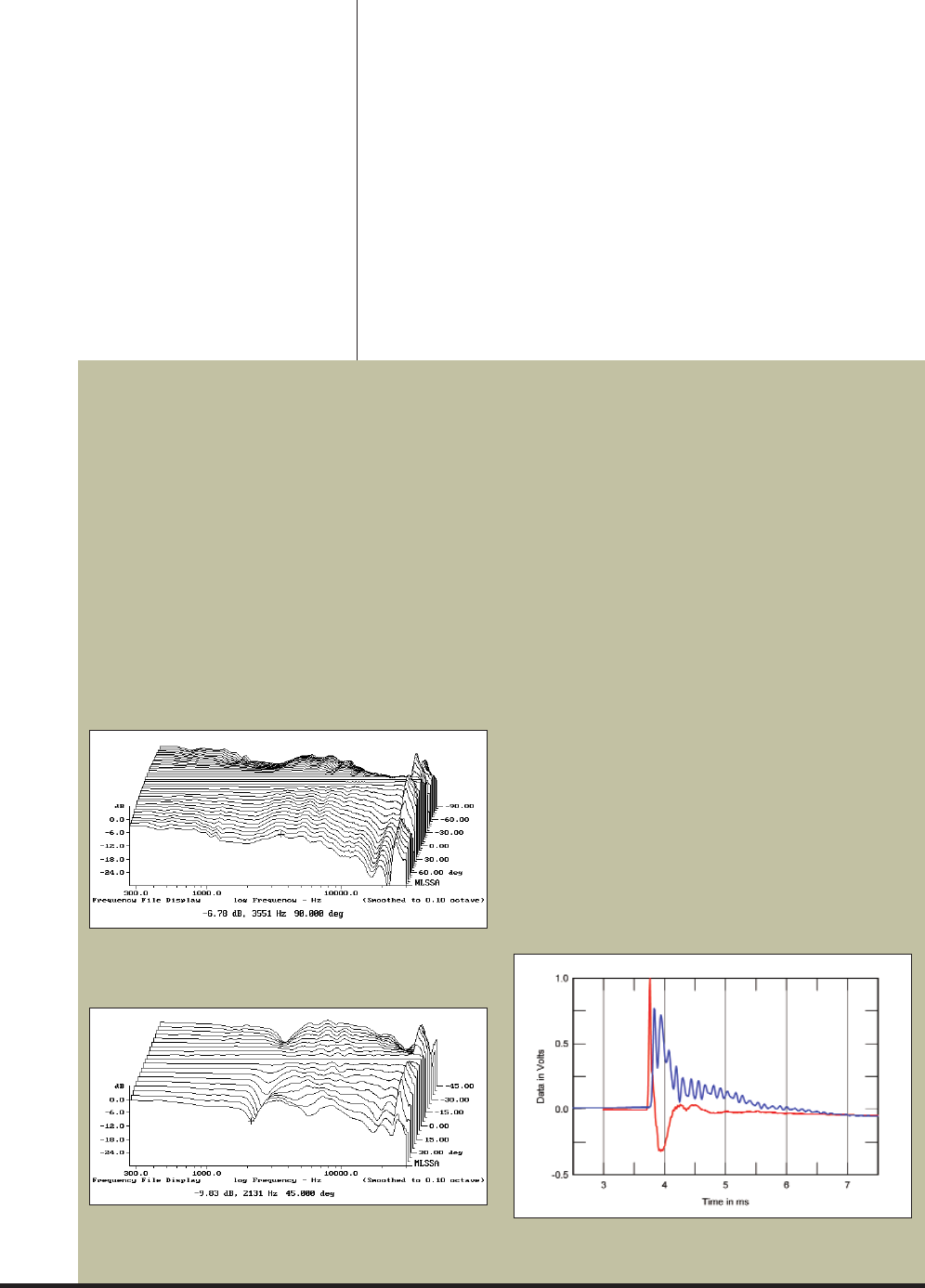
Another was that the basic DEQX unit
cost about $3000, and the price rose
with the addition of A/D, D/A, and
preamp-type controls. Yet another was
the need to have a PC or laptop to do
the number crunching for the mea-
surements, calculations, and setup. Still,
the DEQX enjoys deserved popularity
in recording and mastering studios and
with DIY speaker builders.
The DEQX processing in the XdA
does all the hard work for the user.
Crossover and EQ are customized for
the two-way XdS satellite and XdW
woofer to endow the XdS with a flat
response on-axis and optimal disper-
sion in the horizontal plane. Perfection
in the vertical plane is thwarted by the
physics of stacked drivers, but due to
the very high (108dB/octave!) cross-
over slope, the suckouts above and
below the listening axis are narrowly
restricted. The steepness of the slope
makes possible a relatively low cross-
over frequency for the tweeter (just
above 2kHz) without compromising
its power handling. This, and a
smoothly shaped cabinet devoid of
edges on its front surface, contribute to
the smoothness of the XdS’s off-axis
response. In addition, some low-end
boost is provided at around 26Hz,
which makes the XdW’s in-room
response fairly flat into the 20Hz range
before it begins to roll off.
The XdA also includes four Power-
Physics class-D (switching) amplifier
modules (www.powerphysics.com) to
biamplify the two XdS speakers. While
www.Stereophile.com, November 2005
NHT Xd
measurements, continued
averaged across a 30° horizontal window centered on
the satellite’s tweeter axis. Below 300Hz, this graph
shows the combination’s estimated farfield response,
calculated by adding the nearfield responses of the sub-
woofer and woofer and taking into account acoustic
phase. The region covered by the subwoofer, below
110Hz, can be arbitrarily raised or lowered using the
XdW’s rear-panel volume control. However, it does look
as though the integration between the two units is not
quite as perfect as that between the woofer and tweeter.
Other than that very slight lack of lower-midrange ener-
gy, and the slight shelving-down of the speaker’s output
above 12kHz due to the tweeter becoming more direc-
tional in this region, the NHT speaker system offers
extraordinarily flat response!
It is not only a flat on-axis response that contributes to
a speaker having a neutral balance; its radiation pattern
also has an effect in all but anechoic rooms. Here the
NHT XdS also offered superb performance. Fig.8 shows
its lateral dispersion referred to the response of the
tweeter axis, which has been subtracted from all the
traces so that only the changes are apparent. The con-
tour lines are evenly spaced, and there is only a trace of
the usual off-axis flare at the bottom of the tweeter’s
passband. Other than its restricted dispersion above
12kHz or so, this speaker’s radiation to its sides is not
significantly different from what it puts out in front. In
the vertical plane (fig.9), the use of noncoaxial drive-
units means that suckouts in the crossover region
between the XdS’s tweeter and woofer appear at
extreme off-axis angles. But the use of very steep cross-
over filter slopes means that the XdS is otherwise very
tolerant of listener ear height.
Performing a loudspeaker’s crossover and equalization
functions in the digital domain means that its acoustic
performance, in theory, can be optimized in both the fre-
quency and time domains. So, when examining the
XdS’s time-domain performance, I first looked at the
step responses of the raw drive-units (fig.10). Without
the XdA equalization, the tweeter (red trace) leads the
woofer (blue) very slightly, with the tail of the latter’s
step overlaid by the high-frequency ringing of the cone
breakup modes noted earlier. Repeating these measure-
ments with the XdS driven by the XdA gave the steps
Fig.8 NHT XdS driven by XdA, lateral response family at 50", normalized
to response on tweeter axis, from back to front: differences in
response 90–5° off axis, reference response, differences in response
5–90° off axis.
Fig.10NHT XdS, step responses on tweeter axis at 50" of unequalized
tweeter (red) and woofer (blue). (5ms time window, 30kHz
bandwidth.)
Fig.9 NHT XdS driven by XdA, vertical response family at 50", normalized
to response on tweeter axis, from back to front: differences in
response 45–5° above axis, reference response, differences in
response 5–45° below axis.













